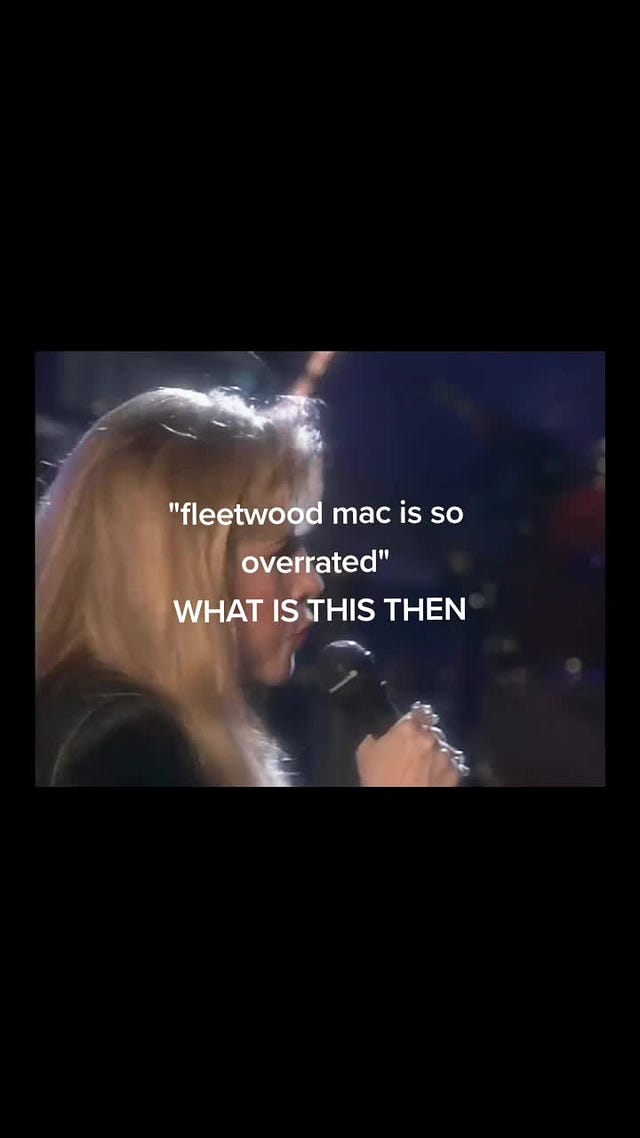📌 On Flinching (or Not)
Staring down your "Why," whether it's Lindsey Buckingham or being in over your head when babysitting
I’ve been thinking a lot about intensity, and I think I can trace a lot of the mind-meanders I’ve had from watching (of all things!) a 30-second TikTok of Stevie Nicks and Lindsay Buckingham’s intense stare-down during their infamous set many years back. (It’s not just me calling it ‘infamous’—for context, here’s a Rolling Stone piece on it, 20 years after the fact!)
It’s gotten me thinking, among other things, about publishing’s constantly ebbing and flowing landscape and what we, as artists, want to share—and what we don’t (at least, not always).
There are so many kinds of stories to tell. In the past, things seemed so delineated: fiction…or non-fiction. And yet that “black and white” still contained a multitude of grey. Sometimes fiction is TRUER than non-fiction (see many celebrity biographies for proof points galore), and some non-fiction facts are best understood through a storyteller to create the suspension of belief necessary to transport a modern-day person into the confounding past.
Maybe because of all this, there has been a stronger and stronger drumbeat sound for creators to tell the stories they know best in the way they know best—to lean in, not flinch, and to own “it”—whatever your “it” is. To ensure that your story is as your story as possible.
And, again, this is where Stevie Nick’s clip is so captivating (at least to me). Imagine performing a reading of your words 20 years into the future, and they captured your “you-ness” and intention so fully that you couldn’t help but be transported back to the time you wrote them, and you brought everyone there along for that visceral ride. That is happening in that clip, and it’s why, more than 20 years later, it’s still being talked about. (I can’t imagine anyone in that audience that day doesn’t have that moment pop up rent-free in their brains occasionally.)
Nicks’s artistic intensity in the clip (and at that show) is essentially just the bravery of sharing, unflinching, exactly what she meant and felt.
I mean, almost everyone is honest and raw—in their head. But sharing that honesty is not natural for…well, nearly anyone. (After all, it would be exhausting to be or be around someone who *never* kept themselves to themselves.) And yet, it’s that open authenticity that drives so much of the power of the connection we hope to create with our readers.
My1 first book comes out next year, and on the surface, I may not have much in common with either the main child character, Freddie, nor the “stack of raccoons in a trench coat” that babysit him. 😂 But what’s interesting to me is how much everything I wrote in this ridiculous story relies on my own very-real experiences. I was a very early babysitter—babysitting my younger brother while I was in elementary school (as was the norm in the 1980s). So, it’s fair to say I *was* as experienced as a stack of raccoons in terms of babysitting in my early days—and we did have outside babysitters of ALL sorts, too, during that same time frame (some of whom I liked—others, not so much). I realize you all have not read the book yet, but trust me when I say it’s more true than the truth—at least for me.
And that’s it, isn’t it? What is your truth? Putting that down on the page—and sharing it—even if your truth is that you were often in over your head (maybe *especially* then).
Finding your why and leaning in. Staring down your Lindsey Buckingham with unflinching eyes.
Which brings me to…why did I write this? (Well, not this post—though, that, too, in a way.) I have been putting more thought into why a particular story “calls” to me, and it’s been an interesting journey! These days, I even add an “author connection” note to the top of all my manuscripts (alongside my pitch) to help me revise with intention.
Do you consider your “why” part of your writing or revising process? If so, do you have any tips for "processing” that aspect?
Your intensely-working friend,
Elayne
My posts are always free, but my focus isn't; if you found this post interesting or useful, please consider ♡' ing it so I know. Thank you!
Along with illustrator John Ledda and the amazing Feiwel and Friends imprint, of course!








This getting to your personal connection/personal why is important and challenging and meaningful. Sometimes I don't think I feel feelings big enough to write the kinds of powerful things I like to read. But the mining proceeds and the "real real" is in there!
This is awesome Elayne! There is always a why to a story and a personal connection to a story— even if it may not seem like it on the surface! Which I think is especially the case with humor stories and non-human stories. But they are still based on something real, come from something real. And I love the author connection note at the top of your manuscripts— I think I might just start doing that too. I’m sure it is definitely helpful when revising— keeping you abreast of the heart of your story at all times, why you wrote it, why you are writing it, and why you want it out in the world.